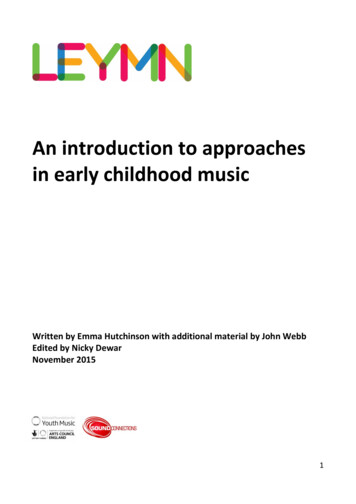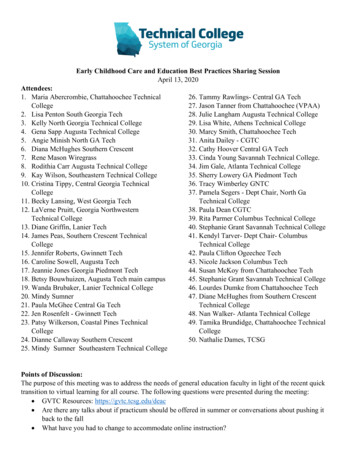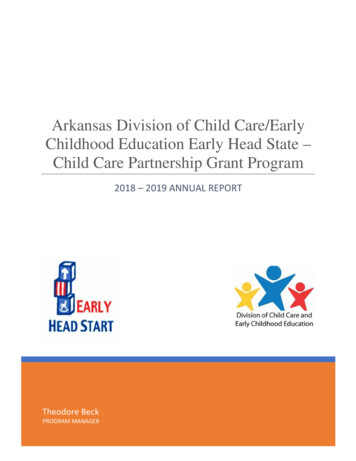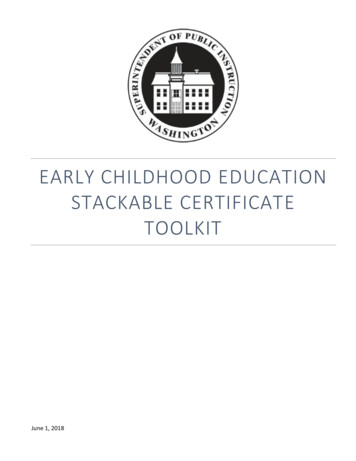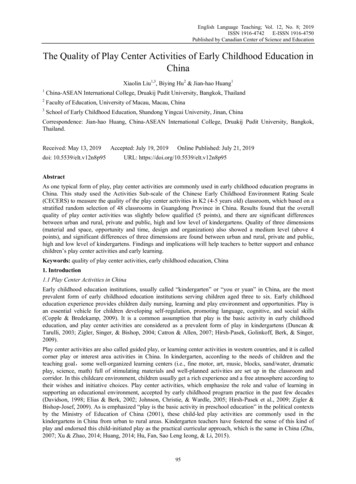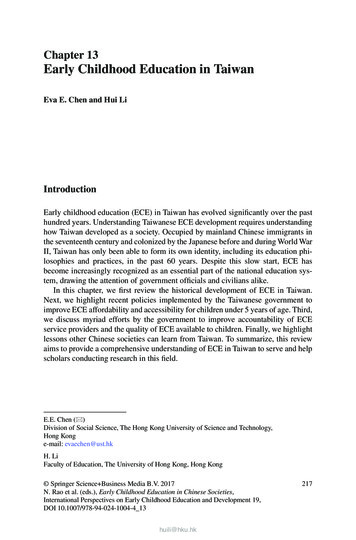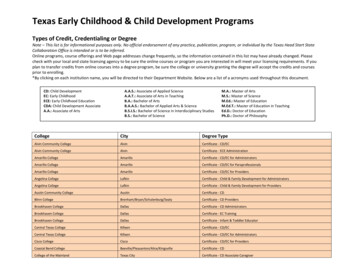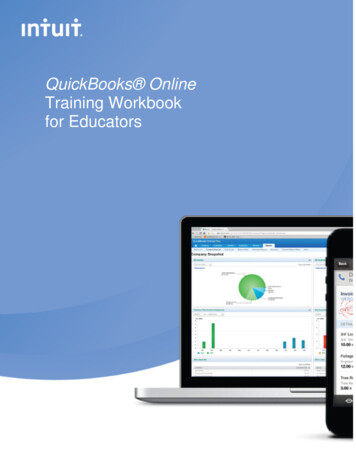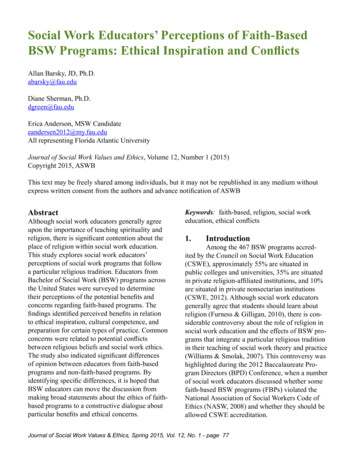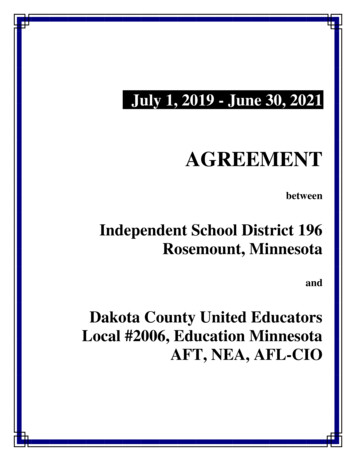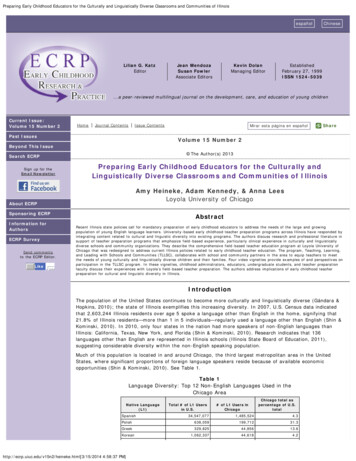
Transcription
Preparing Early Childhood Educators for the Culturally and Linguistically Diverse Classrooms and Communities of IllinoisespañolLilian G. KatzEditorJean MendozaSusan FowlerAssociate EditorsKevin DolanManaging EditorChineseEstablishedFebruary 27, 1999ISSN 1524-5039.a peer-reviewed multilingual journal on the development, care, and education of young childrenCurrent Issue:Volume 15 Number 2HomeJournal ContentsIssue ContentsPast Issues The Author(s) 2013Search ECRPSign up for theEmail NewsletterPreparing Early Childhood Educators for the Culturally andLinguistically Diverse Classrooms and Communities of IllinoisAmy Heineke, Adam Kennedy, & Anna LeesLoyola University of ChicagoAbout ECRPSponsoring ECRPInformation forAuthorsECRP SurveySend commentsto the ECRP Editor.LikeShareVolume 15 Number 2Beyond This IssueMirar esta página en español685AbstractRecent Illinois state policies call for mandatory preparation of early childhood educators to address the needs of the large and growingpopulation of young English language learners. University-based early childhood teacher preparation programs across Illinois have responded byintegrating content related to cultural and linguistic diversity into existing programs. The authors discuss research and professional literature insupport of teacher preparation programs that emphasize field-based experience, particularly clinical experience in culturally and linguisticallydiverse schools and community organizations. They describe the comprehensive field-based teacher education program at Loyola University ofChicago that was redesigned to address current Illinois policies related to early childhood teacher education. The program, Teaching, Learning,and Leading with Schools and Communities (TLLSC), collaborates with school and community partners in the area to equip teachers to meetthe needs of young culturally and linguistically diverse children and their families. Four video vignettes provide examples of and perspectives onparticipation in the TLLSC program. In these vignettes, childhood administrators, educators, undergraduate students, and teacher preparationfaculty discuss their experiences with Loyola’s field-based teacher preparation. The authors address implications of early childhood teacherpreparation for cultural and linguistic diversity in Illinois.IntroductionThe population of the United States continues to become more culturally and linguistically diverse (Gándara &Hopkins, 2010); the state of Illinois exemplifies this increasing diversity. In 2007, U.S. Census data indicatedthat 2,603,244 Illinois residents over age 5 spoke a language other than English in the home, signifying that21.8% of Illinois residents—more than 1 in 5 individuals—regularly used a language other than English (Shin &Kominski, 2010). In 2010, only four states in the nation had more speakers of non-English languages thanIllinois: California, Texas, New York, and Florida (Shin & Kominski, 2010). Research indicates that 136languages other than English are represented in Illinois schools (Illinois State Board of Education, 2011),suggesting considerable diversity within the non-English speaking population.Much of this population is located in and around Chicago, the third largest metropolitan area in the UnitedStates, where significant proportions of foreign language speakers reside because of available economicopportunities (Shin & Kominski, 2010). See Table 1.Table 1Language Diversity: Top 12 Non-English Languages Used in theChicago AreaNative uc.edu/v15n2/heineke.html[3/15/2014 4:58:37 PM]Total # of L1 Usersin U.S.# of L1 Users inChicagoChicago total aspercentage of 29,82544,85613.61,062,33744,6184.2
Preparing Early Childhood Educators for the Culturally and Linguistically Diverse Classrooms and Communities of urce: Shin and Kominski (2010)Suburban areas of northeastern Illinois, including the surrounding communities in Cook County and the “collarcounties” of Kane, Lake, DuPage, and Will, have large and rapidly growing culturally and linguistically diversepopulations (Illinois State Board of Education, 2011). See Figure 1.Figure 1. Percentage of English Language Learners inIllinois Schools by Region. Source: Illinois StateBoard of Education (2011)Children who are labeled as English language learners (ELLs) typically speak native languages in their homesand communities and enter classrooms and schools with varying levels of proficiency in English (Gándara &Hopkins, 2010). Their native languages provide context for learning both the English language and contentareas, such as mathematics, science, and social studies (Illinois State Board of Education, 2011). As of 2008,approximately 20% of children entering kindergarten in Illinois were identified as ELLs. This figure rises to 28%within the city of Chicago and higher in nearby suburban areas (Bridges & Dagys, 2012); however, every partof the state is experiencing growing diversity (Illinois State Board of Education, 2011). See Table 2.Table 2Language Diversity: Top 12 Native Languages of English Learners in IllinoisSchoolsNativeLanguageSpanishCity noisSouthernIllinoisTotal 2014 4:58:37 PM]
Preparing Early Childhood Educators for the Culturally and Linguistically Diverse Classrooms and Communities of IllinoisFrench186261781468679Source: Illinois State Board of Education (2011)Cultural and Linguistic Diversity and Illinois Education PolicyIncreasing cultural and linguistic diversity has prompted policy makers to require preschool programming thathas been designed specifically for bilingual students and ELLs (Malone, 2010; Zehr, 2010). In 2010, the IllinoisState Board of Education (ISBE) adopted rules creating the first statewide system of bilingual preschooleducation in the United States. Amendments to the Illinois School Code (2010) included new provisionsaffecting both identification and education of preschool-aged ELLs as well as professional development andcredentialing of preschool teachers. First, the changes required state-funded preschool programs administeredby school districts to screen for non-English languages spoken in the home and to assess children’s Englishlanguage proficiency. In preschools where 20 or more children share the same native language, the statemandated transitional bilingual education for children to receive native language support. In settings withseveral linguistic backgrounds, English as a second language (ESL) services are required (Illinois State Board ofEducation, 2010).The first of their kind, these policy mandates are intended to significantly increase access ofyoung ELLs to bilingual education, including native and second-language support, across the state (Malone,2010). Illinois school districts and preschool programs must adapt their assessment and instruction to thepolicy requirements; this includes selecting and implementing culturally and linguistically appropriate curriculaand tools for screening and assessment. Such practices are also recommended by the National Association forthe Education of Young Children (2009).The priority of addressing the needs of ELL children and their families extends to other agencies servinginfants, toddlers, and preschoolers. Head Start and Early Head Start programs in Illinois follow the nationalHead Start Program Performance Standards, which require educators to support children in their nativelanguage and in English while providing culturally sensitive and appropriate child and family services inaccordance with the principles of developmentally appropriate practice (Office of Head Start, 2008). TheImproving Head Start for School Readiness Act of 2007 builds upon these requirements, emphasizingprofessional development for educators that focuses on the needs of children with limited English proficiency;immigrant, refugee, and asylee families; and children of migrant or seasonal farmworker families (ImprovingHead Start for School Readiness Act of 2007). Early Head Start programs also support home language as wellas culture and family literacy by maximizing infants’ and toddlers’ consistent access to teachers whounderstand families’ cultures and who, ideally, speak the first language of the families they serve (Early HeadStart National Resource Center, 2001).Expectations of early childhood professional preparation have also changed to ensure that teachers haveadequate knowledge and skills to meet the developmental needs of young ELLs (García & Frede, 2010;Severns, 2010). The Illinois State Board of Education (2010) extended policies beyond bilingual and ESLprogramming to require specific preparation, credentialing, and professional development of early childhoodeducators. By 2014, all teachers who serve children in bilingual and ESL preschool settings will be required tohave corresponding endorsements on their Illinois teaching licenses. The endorsements consist of at least 18university credit hours of instruction and 100 clinical hours with culturally and linguistically diverse students(Illinois State Board of Education, 2013). Preschool providers are also required to participate in professionaldevelopment to build their understanding and competencies in language acquisition and culture (Illinois StateBoard of Education, 2010).At the time these rules passed, less than 1% of early childhood educators in Illinois had bilingual or ESLcertification, and few teacher education programs offered preparation leading to these credentials (Bridges &Dagys, 2012). Since then, teacher education programs in public, private, two-year, and four-year institutionsacross Illinois have collaborated to incorporate content that promotes teacher candidates’ effectiveness withculturally and linguistically diverse learners in early childhood settings (Illinois Resource Center, 2013) byadjusting existing course content, adding new courses and field experiences, or instituting new endorsementprograms.In this paper, we describe how Loyola University of Chicago prepares early childhood educators for cultural andlinguistic diversity in schools and communities. We begin by grounding our work in the related literatureCommunity-based Teacher PreparationScholars (García, Arias, Harris Murri, & Serna, 2010) and organizations (American Association of Colleges ofTeacher Education, 2010; National Council for Accreditation of Teacher Education, 2010) recognize the centralrole of clinical experiences and of school and community partnerships in preparing culturally and linguisticallyresponsive teachers (Gay, 2010; Lucas, Villegas, & Freedson-Gonzalez, 2008). Research suggests thatuniversity and community collaborations for teacher preparation have direct positive impact on teachercandidates (Kruger, Davies, Eckersley, Newell, & Cherednichenko, 2009) by providing opportunities to interactin diverse educational settings and experience community-specific methods of teaching and learning (Murrell,2000). Practice-based approaches to learning (Ball & Cohen, 1999; Murrell, 2000) are seen as /15/2014 4:58:37 PM]
Preparing Early Childhood Educators for the Culturally and Linguistically Diverse Classrooms and Communities of Illinoiscandidates’ resiliency and cultural understandings (McDonald et al., 2011) and providing authentic, accurate,and thorough preparation for responding to the needs of students in a variety of settings (García et al., 2010).University-community partnerships engage community teachers and leaders as co-teacher educators (McDonaldet al., 2011; Murrell, 2000). These individuals’ cultural competence regarding their neighborhoods, along withtheir dedication to sustaining local schools and communities, enables them to facilitate teacher candidates’understanding of the roles of family and community in the lives of the children they work with (McDonald etal., 2011). Community members encourage candidates to use this knowledge to develop culturally relevantteaching strategies and are often described as more influential in candidates’ understandings of diversity thanuniversity faculty (McDonald et al., 2011). Participating university faculty members monitor and explicitly linkthe candidates’ community-based experiences to instructional content (Zeichner, 2006). Structured experiencesin diverse settings are seen as supporting teacher candidates’ personal and professional development bypromoting their understanding of and commitment to such settings (Murrell, 2000; Zeichner, 2006).Community-based teacher education engages candidates in authentic experiences with teaching and learning indiverse communities where they will teach (Murrell, 2000). Candidates cultivate teaching practices gradually inlow-risk settings before entering high-stakes classroom situations (e.g., student teaching), consistent with thedevelopmental process of learning how to teach (Ball & Cohen, 1999). Ongoing exposure to unique and diversecommunity and school settings helps them develop knowledge and skills for culturally and linguisticallyresponsive practice (García et al, 2010). Research suggests that community-embedded partnerships andexperiences allow candidates to engage with social justice issues (Murrell, 2000); reconsider stereotypes ofdiverse youth (Gildin & Onore, 2010); dismantle assumptions about poverty and diverse communities(McDonald et al., 2011); understand the value of informal, community-based learning experiences (Gildin &Onore, 2010); and recognize the assets and resources of families, homes, and communities (Burant & Kirby,2002; McDonald et al, 2011).Scholars have called upon early childhood teacher education programs to bridge theory and course content tofield experience and practices in order to meet the needs of the increasingly diverse child population (Lim &Able-Boone, 2005; Ragan, 2000; Rust, 2010). To that end, they have advocated field placements that prepareeducators to teach young children from backgrounds different from their own (Ragan, 2000). Scholars havealso recommended active university-community partnerships that place coursework into the field, where facultyand community practitioners can co-teach and mentor candidates (Lim & Able-Boone, 2005). Nevertheless,related research indicates that traditional teacher preparation programs seldom bridge practice and theory(Ragan, 2000), do little to influence candidates’ cultural understandings (Lim & Able-Boone, 2005), andincorporate little school and community involvement (Hyun, 2001). Absent from examples of practice areuniversity-community partnerships that provide authentic experiences to prepare candidates for teaching indiverse early childhood settings (Murrell, 2000; Zeichner, 2006).Teaching, Learning, and Leading with Schools and CommunitiesBuilding upon this related literature and organizational calls for clinically based teacher education (AmericanAssociation of Colleges of Teacher Education, 2010; National Council for Accreditation of Teacher Education,2010), Loyola University of Chicago’s teacher education program develops partnerships with a range of schoolsand community organizations to equip future educators to meet the needs of young culturally and linguisticallydiverse children.Field-based Teacher Preparation through PartnershipsLoyola’s teacher education program, Teaching, Learning, and Leading with Schools and Communities (TLLSC),uses an innovative four-year model designed by teacher preparation faculty. Planned using backward design(Wiggins & McTighe, 2005), TLLSC recognizes that every teacher needs certain enduring understandings,knowledge, skills, and dispositions to become a professional committed to social justice who can meet theeducational needs of every student. Candidates engage in a series of entirely field-based modules andsequences at diverse urban and suburban, public and private, school- and community-based educationalinstitutions, progressing through three professional development phases across four years to explore,concentrate, and specialize in early childhood education for cultural and linguistic diversity (Castro, Ayankoya,& Kasprzak, 2011; Division of Early Childhood, 2010).TLLSC not only takes place in schools and communities but also engages teacher preparation faculty withpartners in program design and implementation. School and community partners function as co-teachereducators with shared responsibility for preparing teachers, improving education, and ultimately supporting andimpacting child development and achievement. Partners have contributed to the development andimplementation of TLLSC curriculum and instruction by identifying particular areas of expertise, hosting clinicalexperiences, and mentoring teacher candidates in collaboration with faculty. Schools and communityorganizations have also identified areas for their own growth, as TLLSC partnerships are reciprocal andmutually beneficial (Kruger et al., 2009) with all participants co-constructing knowledge around the education ofchildren from birth through high school [3/15/2014 4:58:37 PM]
Preparing Early Childhood Educators for the Culturally and Linguistically Diverse Classrooms and Communities of IllinoisEarly Childhood Teacher Development for Cultural and Linguistic DiversityResponding to the needs of school and community partners, Loyola faculty committed early on to preparing allteacher candidates to teach all students, focusing particularly on culturally and linguistically diverse childrenand families. They adopted a targeted and integrated approach to prepare all candidates to be effective withculturally and linguistically diverse students, corresponding to Illinois state policy recommendations for earlychildhood professional preparation (Illinois State Board of Education, 2010). Field experiences, instruction, andsupport are integrated throughout the program (Division for Early Childhood, 2010). Candidates participate in aseries of modules (clinical experiences of variable length) to develop knowledge, skills, and disposition relatedto language and culture (Castro et al., 2011). Following recommendations by scholars (e.g., Valdés, Bunch,Snow, & Lee, 2005), this approach (a) targets foundations central to teaching ELLs in the exploration phase,(b) extends foundations specifically to young children in the concentration phase, and (c) integrates culturaland linguistic diversity into authentic practice with early childhood teaching and learning in the specializationphase.Figure 2: TLLSC Phases and SequencesView PDFThe exploration phase begins in freshman year and takes place over three semesters, during which candidatesfulfill state ESL endorsement requirements related to linguistics, foundations, cross-cultural methods, andassessment. In this phase, candidates first learn theory and practice for working with culturally andlinguistically diverse students, families, and communities through participation in modules that include fieldplacements. Instruction focuses on topics related to language, learning, and development, including firstlanguage development, second-language acquisition, and foundational linguistic principles (Valdés et al., 2005).In the second sequence of this phase, candidates explore ways to use student, family, and community funds ofknowledge (M
At the time these rules passed, less than 1% of early childhood educators in Illinois had bilingual or ESL certification, and few teacher education programs offered preparation leading to these credentials (Bridges & Dagys, 2012). Since then, teacher education programs in

